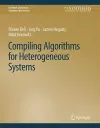
Compiling Algorithms for Heterogeneous Systems
4 authors - Hardback
£49.99
Steven Bell is a Ph.D. candidate at Stanford University, where he's building camera platforms as a vehicle to explore the challenge of rapidly creating high-performance hardware/software systems. As part of his Ph.D. work, he has developed imaging algorithms, written kernel drivers, and wrangled FPGA tools. His interests include image processing and computational photography, embedded software and systems, and teaching these topics to others. He received a B.S. in computer engineering from Oklahoma Christian University in 2011.Jing Pu received a B.S. in microelectronics from Peking University and an M.S. and Ph.D. in electrical engineering from Stanford University. He is currently working on Pixel Visual Core and Halide at Google. During his Ph.D., he worked on programming CPU/FPGA heterogeneous systems from the Halide image processing language. His research interests include domain-specific architectures and compilers, computer vision, and deep learning.James Hegarty is a research scientist whose work looks at developing new hardware design methodologies to enable rapid hardware-software co-design of low power image processing and computer vision systems. James' recent work involved the development of the Darkroom and Rigel image processing hardware languages. Previously, James worked on graphics systems, where he helped develop a novel real-time GPU rendering system that reduced shading load by 9x on micropolygon workloads. James holds a B.S., M.S., and Ph.D. in computer science from Stanford University.Mark Horowitz is the Yahoo! Founders Professor at Stanford University and was chair of the Electrical Engineering Department from 2008–2012. He co-founded Rambus, Inc. in 1990 and is a fellow of the IEEE and the ACM and a member of the National Academy of Engineering and the American Academy of Arts and Science. Dr. Horowitz's research interests are quite broad and span applying EE and CS analysis methods to problems in molecular biology to creating new design methodologies for analog and digital VLSI circuits.